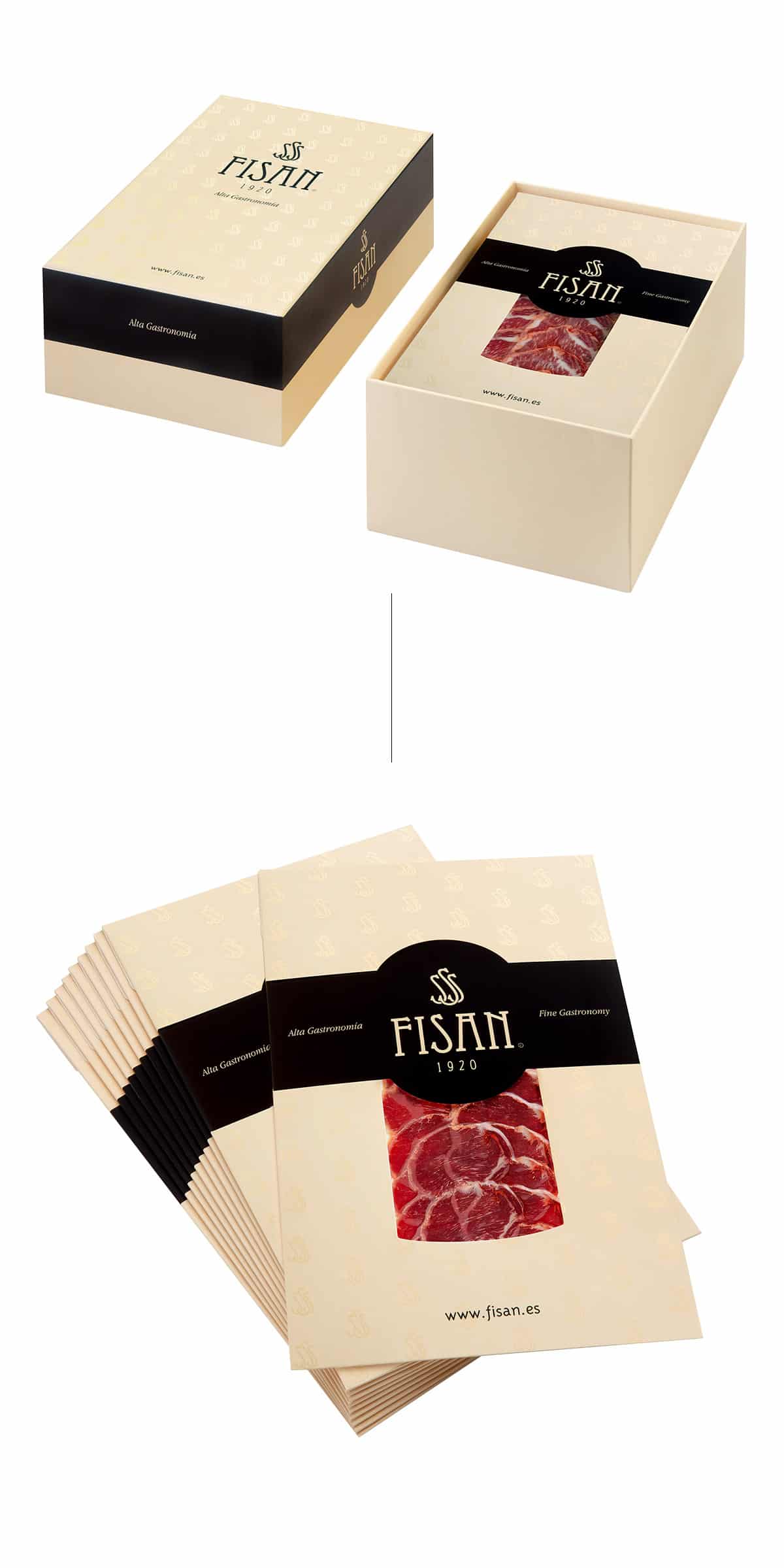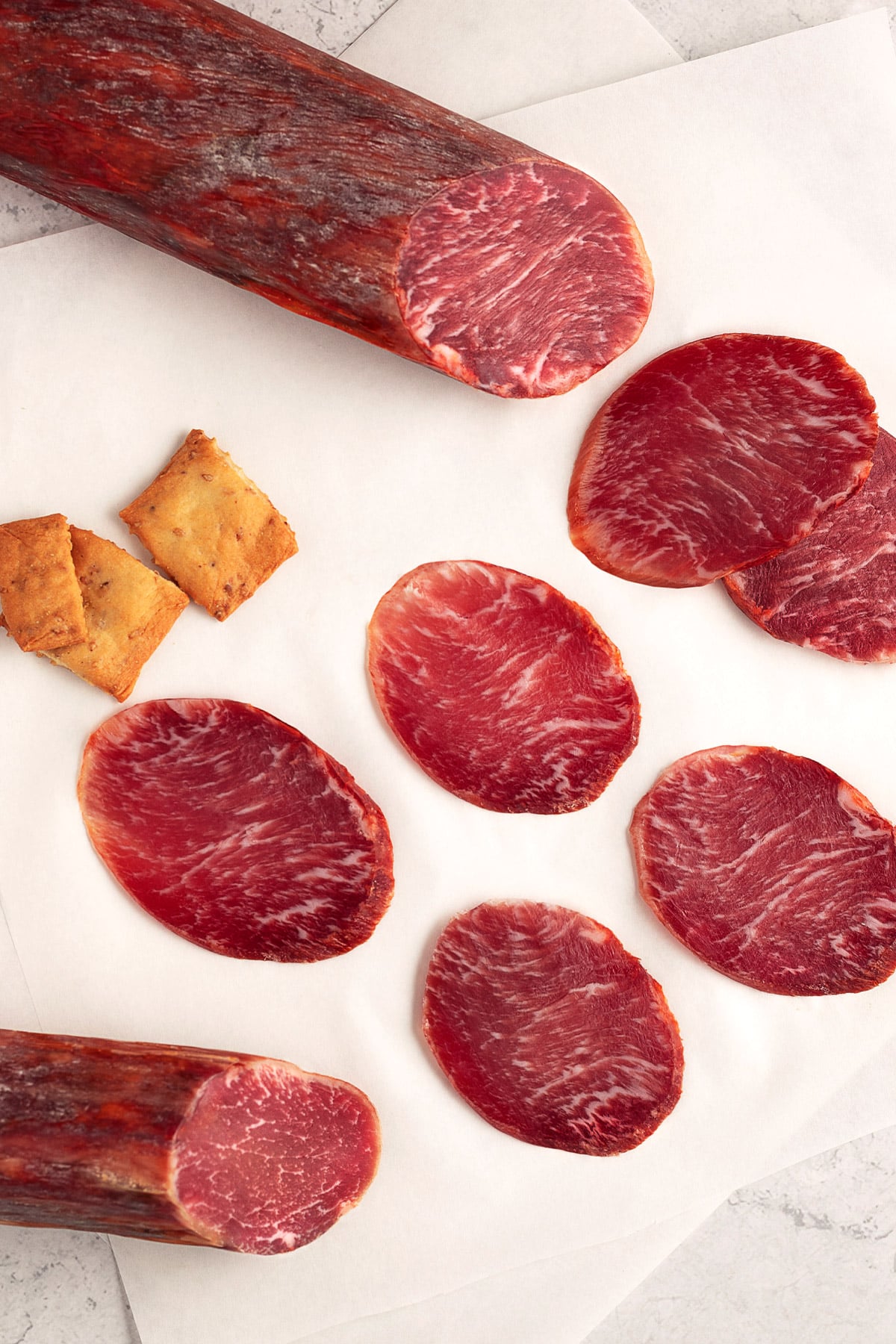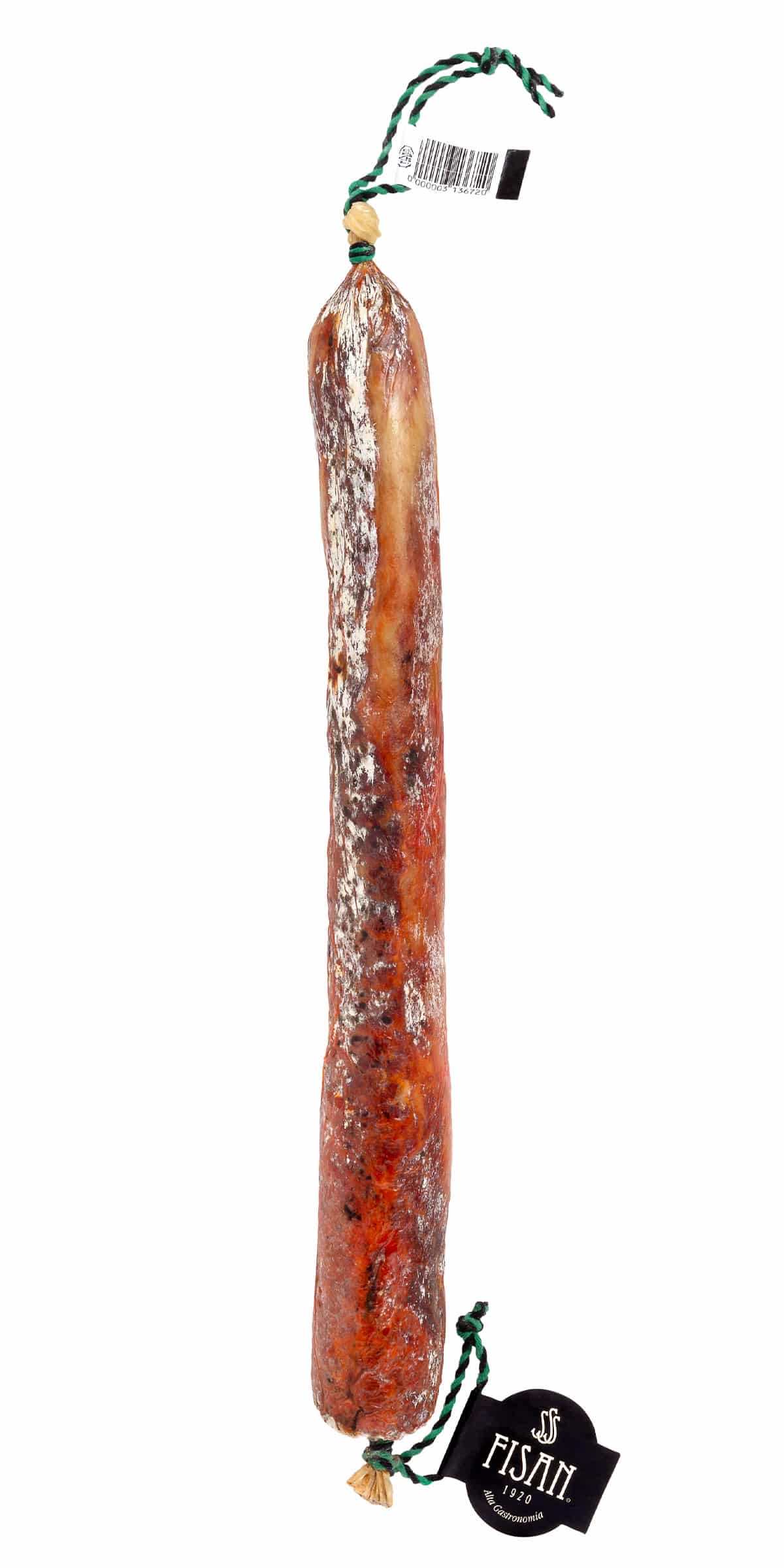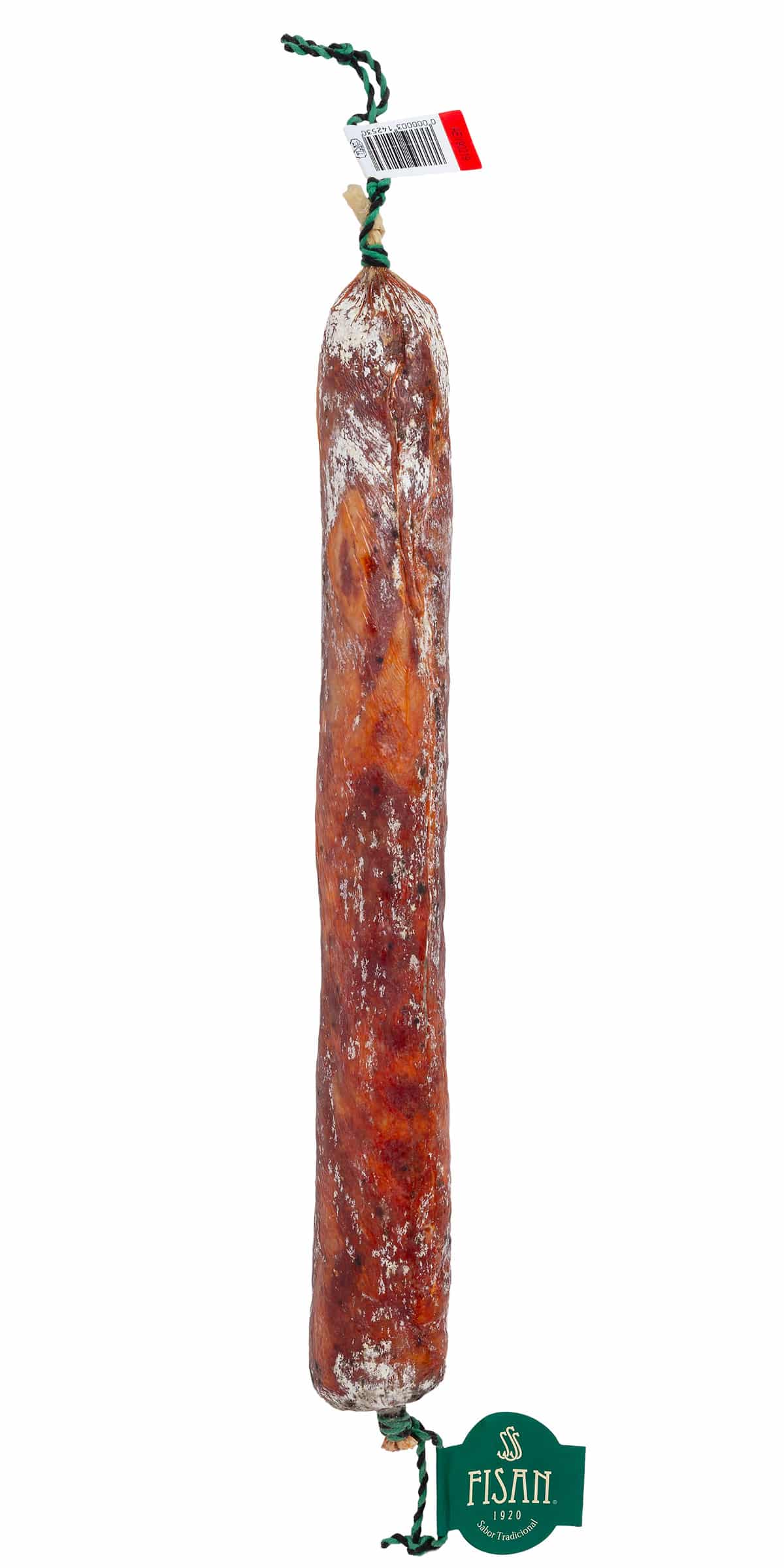FISAN bellota loin pieces are known for their quality and careful curing, but what ends up conquering the palate is its delicious taste of tradition. 100% natural products from pigs that have been exclusively fed with bellotas. Set a date for your next tasting and enjoy bellota Iberico loin. A unique culinary experience!


The 11 most frequently asked questions about bellota loin
WHAT IS BELLOTA LOIN?
Bellota loin is a piece that comes from an Iberico pig that has been exclusively fed with bellota (acorns).Once the whole piece is seasoned with paprika, it is stuffed into natural tripe and left to cure for a minimum of six months. After the maturing and drying time has been completed, the bellota loin is ready for consumption.
WHAT PART OF THE PIG DOES BELLOTA LOIN COME FROM?
Bellota loin is extracted after the Iberian breed pig is butchered.This elongated part is located in the lower back area, next to the animal’s backbone. It is a highly valued whole piece that, after its artisanal preparation and curing in FISAN’s cellars, gives exquisite bellota Iberico loins.
TYPES OF BELLOTA IBERICO LOIN
FISAN bellota Iberico loin falls within the classification established by the current Iberico Standard. As is the case with ham and shoulder ham, the quality of bellota Iberico loin can be told by its seal:
- Black seal: bellota 100% Iberico loin bears a black seal which means that it has been prepared with meat from pigs whose parents are 100% Iberian breed. Besides, they have fed on bellotas and other natural resources found in the dehesa. Bellota 100% Iberico loin belongs to the FISAN Alta Gastronomía selection.
- Red seal:: bellota loin 50% Iberian breed comes from pigs born from a 100 % Duroc-Jersey father and a 100 % Iberian breed mother and have fed on bellotas during the montanera season. In FISAN they are categorized as Sabor Tradicional products.
- Green seal:FISAN cebo de campo Iberico loin is also included in the Iberico Standard, bearing a green seal. This means that the 100%, 75% or 50% Iberian breed pig has fed on natural pastures and feeding stuffs in the field.
After a slow curing process, the bellota Iberico loin, which can be identified by its seal, is very high in nutrients, quality proteins and vitamins. In FISAN you can choose the bellota loin format that suits you best:
- Whole piece
- Two half-piece pack
- Hand carved in thin slices
Enjoy a 100% natural product prepared with a traditional seasoning based on paprika de la Vera and salt.
Find the quality you are looking for in FISAN products and buy our bellota Iberico loin. Flavours to be shared!
WHAT IS THE DIFFERENCE BETWEEN BELLOTA LOIN AND CEBO LOIN?
Bellota loin and cebo loin differ in what the pig has eaten during the fattening period:
- In bellota loin, the animal has fed on bellotas and other natural resources that are available in the dehesa during the montanera.
- Cebo loin comes from pigs fed with feeding stuffs and cereal.
The Iberico Standard, which classifies products according to the animal’s diet, helps to differentiate Iberico qualities using a colour code for the seals of Iberico loin.
At FISAN we artisanally prepare both bellota Iberico loin and cebo de campo Iberico loin, which also differ as follows:
- The percentage of fat marbling in the form of streaks is higher in bellota than in cebo loin.
- The taste of bellota loin includes sweet nuances, while cebo loin is milder.
- The texture of bellota loin is juicer than that of cebo loin.
WHICH IS BETTER, BELLOTA OR CEBO LOIN?
Bellota loin is considered to be of higher quality than cebo loin.. The pig’s bellota-based diet, along with its physical activity in the dehesa, contribute to making bellota loin outstanding for its fat marbling and exquisite flavour.
Bellota loin meets the expectations of the most demanding palates thanks to the intensity that characterizes gourmet products.. However, although the quality of bellota loin is higher, it also depends on the diner’s taste.
At FISAN we prepare cebo de campo Iberico loin from pigs raised in semi-freedom conditions, products that are as extraordinary as they are tasty.
HOW TO KNOW IF IT IS A BELLOTA 100% LOIN
- The pig feeds only on acorns during the fattening period.
- The seal on the loin is black (100% Iberian breed) or red (75% or 50% Iberian breed).
- Its flavour is intense, with sweet notes and visible fat marbling when cut.
HOW IS SPANISH BELLOTA LOIN CONSUMED?
The most common ways of consuming Spanish bellota loin are: finely sliced as a tapa or snack or in a delicious bread sandwich.Once the curing period is over and it has reached its optimum maturity, bellota loin can be bought in different formats:
- whole
- in pieces
- sliced
This delicious pork product needs no special complements to delight the palate. All you must do is cut it directly into slices or small cubes to enjoy its qualities.
Although, apart from proper drying, no prior preparation is required to consume bellota loin, there are recipes that include it as an ingredient.. These are some ideas:
- Hornazo: a type of pie filled with loin, ham and cured meats
- Bellota loin tartar
- Small rice-filled loin rolls
- False carpaccio made with loin
- Bellota loin and cheese pizza
To round off a top culinary experience with bellota loin all that is left to do is choose what to combine it with.. This gastronomic delicacy pairs well in the mouth with tempranillo, Fino or Manzanilla wines. Aromatic and fruity hints go nicely with bellota loin and balance its intense flavour. As well as pairing it with wine, you can also try it with mild beers.
WHAT IS THE DIFFERENCE BETWEEN LOIN AND LOMITO OR PRESA LOIN? WHICH IS MILDER?
-
The difference between loin and cured presa or lomito is the part of the pig that the meat cut comes from in the butchering process:
- Bellota loin is located in the lower back area, next to the pig’s backbone.
- Lomito comes from presa, a small piece located between the pig’s shoulder blades.
Loin is milder and more tender than lomito or bellota Iberico presa loin.
- Lomito has a stronger taste and more fat marbling than loin.
- The juiciness of its meat and its smaller size are what differentiate lomito from FISAN bellota loin.
WHAT DOES AN IBERICO BELLOTA PIG EAT?
Bellotas are the staple food in an Iberico bellota pig ‘s diet. The fruit starts falling from the holm oaks in October, marking the beginning of the montanera, the season when the pig roams freely in the dehesa until March, achieving the following figures:
- It covers 14 kilometres a day.
- It eats around 9 kg of food a day from acorns, grass and roots.
- It doubles its weight in little more than three months.
The FISAN pig has 3 hectares of land to enjoy, which is double the area established by the Iberico Standard. This is why the so-called double montanera FISAN ensures an optimum amount of bellotas and the bellota pig’s full fattening.
WHERE ARE BELLOTA PIGS RAISED?
Bellota pigs are raised in the dehesa, a balanced ecosystem that includes all the necessary resources for the pig to fully develop. In Spain, there are several dehesa areas, some outstanding locations are:
- Extremadura
- Area of los Pedroches, in Córdoba
- Sierra de Aracena, between Huelva and Seville
But, what conditions does the dehesa have to make it the ideal habitat to raise the pigs that produce the best bellota loin?
- Large extensions of land to favour free roaming.
- Many holm and cork oaks with plenty of acorns.
- Peaceful natural environment.
HOW MUCH DOES AN IBERICO BELLOTA PIG WEIGHT?
An Iberico bellota pig can reach a weight that ranges from 160 to 190 kgs.. Once that figure is reached, at the end of the montanera, the pig slaughtering period begins, which, according to the Iberico Standard, goes from 15 December to 31 March.
On orders over €100
All payments made in our store are secure.

